Beginnings of SDN Lady McKell, Goulburn
‘A child’s idea of paradise—a wonderland where you have the choice of walking down stairs or taking a slippery dip.’ Article on the opening of SDN Lady McKell, Goulburn Evening Post, 12 January 1954
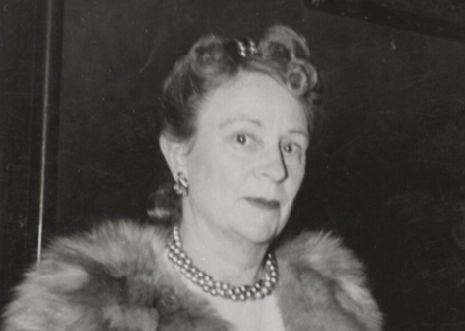
Lady McKell, c.1950. Source: National Library of Australia
SDN Children's Services begins in 1905
In 1905 a determined group of women from Sydney’s upper classes who understood ‘the difficulties that beset the paths of working mothers’ founded the Sydney Day Nursery Association. The Association aimed to improve the welfare of children whose mothers were facing poverty and had to work to provide for their family. Infant mortality was high and the Kindergarten Union was only able to provide daycare services for a few hours a day. With no other option, these young children were often left to fend for themselves among the streets of working class Sydney.
In response, the Association opened its first Day Nursery in a terrace house in Dowling Street, Woolloomooloo in 1905, the first long daycare centre in NSW. For just three pence a day, babies and children were bathed, fed, clothed and cared for from 7.00am to 6.30pm.
Due to overwhelming demand, the Association opened Day Nurseries in five more locations in the inner city soon after. These were all areas of need in Sydney with large working populations.
History of Goulburn
The area now known as Goulburn Mulwaree was originally a very important meeting place for various Aboriginal clan groups, owing to its abundance of native game and fish [1].
European surveyor James Meehan visited the area in 1818, naming it after Henry Goulburn, Under-Secretary for War and the Colonies.
Goulburn was gazetted in 1833, and by 1841 the population had reached 1,200 residents, serviced by a courthouse, police barracks, churches, hospital and post office. Goulburn was granted city status by Queen Victoria in March 1863, establishing it as the Diocese of Goulburn and Australia’s first inland city.
The opening of the Great Southern Railway’s terminus in Goulburn in 1869 laid the foundations of the boom period of the 1880s and 90s, when wheat and wool production in the area was at its peak. The city became a hub for law and church administration, its legacy being the many fine buildings of architectural significance around Goulburn today.
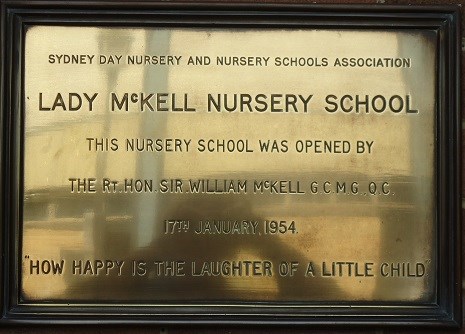
Lady McKell Nursery School's opening plaque. Source: SDN Archive
SDN's journey to a Nursery School in regional NSW
On 26 July 1944, the Goulburn Day Nursery Committee was established, led by Miss Twynam and assisted by many members from the local community. It would mark the start of a long and often difficult journey towards the opening of the Association's third regional Nursery School. Funding for the new Nursery School was initiated by Mrs Mary McKell (later to become Lady McKell), wife of the Governor-General of Australia, Sir William McKell.
The £3,000 had been personally raised by Lady McKell over a number of years from friends who supported her interest in children’s welfare. Two subsequent years of fundraising culminated in the purchase of a block of land on Back Street and the laying of the foundation stone on 13 April 1947 by Mrs McElhone, President of the Sydney Day Nursery and Nursery Schools Association.
But while completion of the building on that site was expected by 1949, the land was subsequently requested back by Goulburn Council. After much negotiation, a more appropriate site with good transport access was eventually located at McKell Drive.
Hampered by extreme weather conditions in 1949, and a shortage of building materials in 1950, building work at the new site was delayed once again. As a sign of their ongoing commitment to the future centre, the McKells each planted a silver birch at what would be the entrance to the Nursery. Silver birches still grow in the grounds today, giving a nod to the past.
Despite the delays, the Committee forged ahead with fundraising, ensuring that the centre would be well furnished and equipped. Money was also raised to fund a Scholarship to SDN’s Nursery School Training College, to support the training of a Nursery School teacher for the new centre.
Finally, in 1952, building commenced and it was unanimously agreed to name it the Lady McKell Nursery School, in honour of its most generous benefactor and supporter.
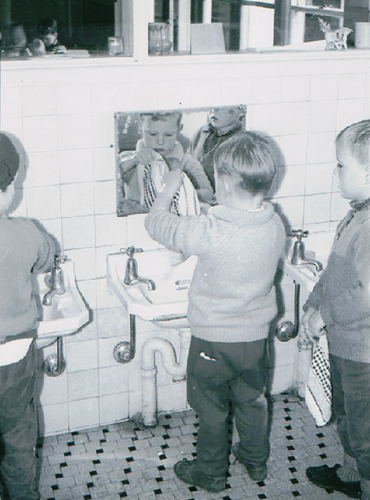
Hand washing at SDN Lady McKell, 1965. Source: SDN Archive
The Lady McKell Nursery School opens in 1954!
On a humid day on 17 January 1954, the Lady McKell Nursery School was officially opened by Sir William McKell to a crowd of 200 well-wishers.
Designed by architect Hedley Carr (who also designed SDN Hamilton Street in Bathurst), the centre was deemed state of the art. Its design and construction maximised the amount of light and air to the playrooms and dining room. A well-protected open-air play area was equipped with a paddling pool and sandpit. In 1955, Sir William and Lady McKell donated a jungle gym and rocking boat for the outdoor play area. The opening of the centre was an historic day for the city of Goulburn, who were proud to have a Nursery School providing such modern facilities.
The children of working mothers were a priority at the new Nursery School, but casual attendances were also accepted. Country children whose mothers were in Goulburn for errands, or local children whose mothers were attending appointments, were permitted to attend the centre.
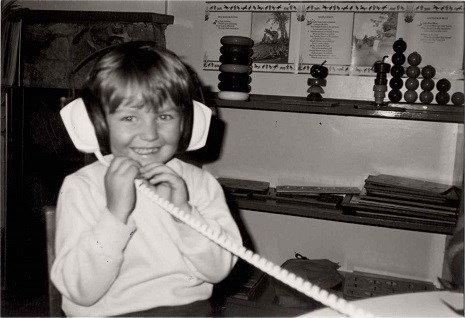
Listening to music, SDN Lady McKell, 1986. Source: SDN Archive
A history of fundraising at SDN Lady McKell
SDN Lady McKell was made possible through the tireless fundraising of the Goulburn Day Nursery Committee and the Mother’s Club. Kick-started by Lady McKell’s own fundraising and donation of £3,000, money was donated from Goulburn City Council, local businesses and charities, friends and families. The Evening Post and radio station 2GN provided welcome publicity for fundraising events.
The Goulburn Day Nursery Mothers’ Club was established in July 1956, and continued for many decades under several guises, enthusiastically raising money though cake stalls, fashion parades, a Miss Goulburn competition, dinner dances, a wig demonstration and monthly cent drives. The money they raised paid for toys, books, furniture and maintenance of the building.
The McKells were intrinsically involved in the centre throughout their lifetime, made easy by the proximity of their rural property to Goulburn. Sir William McKell provided a further £100 at the opening ceremony and Lady McKell later purchased a beautiful walking doll while on holiday in Gibraltar, raffle tickets for which were sold by Knowlman & Sons department store in town.
‘The equipment provided here is very expensive and I would say it’s the most modern of its kind in Australia’ Miss Ethel Lakeman, Supervisor of the Nursery School Training College, January 1954.
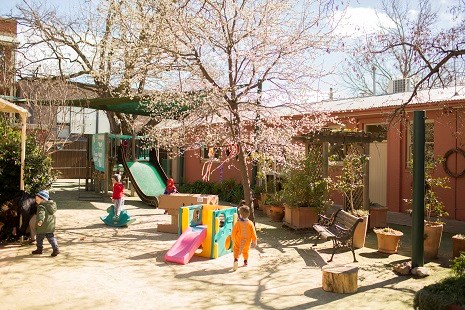
SDN Lady McKell, 2013. Source: Anna Zhu
SDN Lady McKell today
SDN Lady McKell’s journey to its opening in 1954 may have had its challenges, but SDN’s conviction in the benefits of the Nursery School to children and local families never faltered. The building has undergone alterations since it opened, but SDN Lady McKell still reflects a strong connection with our families within this vibrant and diverse community.
The changes in the sector to increase the quality of early childhood education and care have confirmed our own approach to professional skilled staff and services since our beginnings.
What hasn’t changed is our vision and commitment to addressing social inequalities, improving children’s quality of life and enhancing the life chances for all children.
About this history and the SDN Archive
This history was put together from documents held in the SDN Archive, Goulburn Mulwaree Council, National Library of Australia and State Library of Victoria.
The SDN Archive, established in 2002, is a unique resource in Australia’s early childhood education sector. You can see the SDN Archive on HistoryPin.
SDN Children’s Services runs more than 20 children’s education and care centres throughout NSW and the ACT, as well as providing a range of children and family support programs.
Download a PDF of this article here.
[1] Source: Goulburn Mulwaree Council

